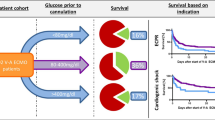Abstract
The development of metabolic acidosis during cardio-pulmonary bypass (CPB) is a well recognized but poorly explained phenomenon. It has been hypothesized that it is purely a development after the delivery of pump prime. A retrospective study was conducted at our hospital on 68 patients who underwent elective coronary artery bypass grafting (CABG). Sampling of arterial blood was performed at three time intervals: (T1) Baseline, prior to induction; (T2) 5 minutes after initiation of CPB and prior to administration of cardioplegia solution; (T3) during rewarming prior to weaning the patient off CPB. Measurements of Na+, K+, Cl−, pH, pCO2, HCO3 −, Base excess, Anion gap, Strong ion difference at each collection point were performed. Results were analyzed in a quantitative manner. On delivery of pump prime, all patients' developed metabolic acidosis. However, it is very important to distinguish the metabolic acidosis as their management varies. Anion gap has been found to be useful in managing peri-operative metabolic acidosis.
Similar content being viewed by others
References
Liskaser, F.J., Bellomo, R., Hayhoe, M., Story, D., Poustie, S., Smith, B., Letis, A. and Bennet, M. (2000). Role of pump prime in the etiology and pathogenesis of Cardiopulmonary bypass-associated acidosis. Anesthesiology, 93. 1170–3.
Harris, E.A., Seelye, E.R. and Barratt-Boyes, B.G. (1970) Respiratory and metabolic acid-base changes during cardio-pulmonary bypass in man. Br. J. Anaesth. 42, 912–21.
Scheingraber, S., Rehm, M., Sehmisch, C. and Finsterer, U. (1999) Rapid saline infusion produces hyperchloremic acidosis in patients undergoing Gynecologic surgery. Anesthesiology, 90, 1265–70.
Ernest, D., Herkes, R.G. and Raper, R.F. (1992) Alterations in anion gap·following cardio-pulmonary bypass. Crit. Care Med. 20, 52–6.
Stewart, P.A. (1983) Modern quantitative acid-base chemistry. Can. J. Physio. Pharmacol. 61, 1444–61.
Author information
Authors and Affiliations
Rights and permissions
About this article
Cite this article
Sanjay, O.P., Kilpadi, K. Role of pump prime in the etiology of cardio-pulmonary bypass associated acidosis. Indian J Clin Biochem 17, 42–44 (2002). https://doi.org/10.1007/BF02867940
Issue Date:
DOI: https://doi.org/10.1007/BF02867940




